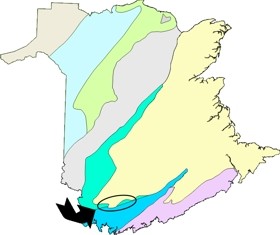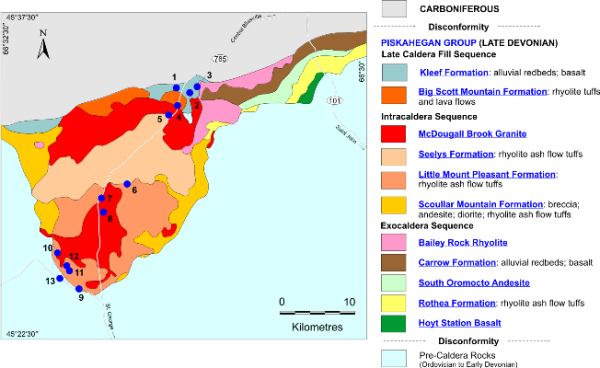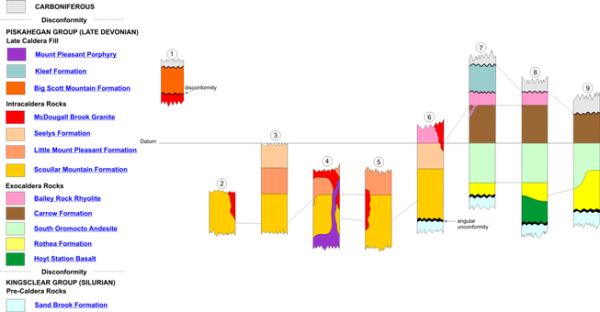The Mount Pleasant deposits are associated with hydrothermal breccias and intrusive rocks that cut the Intracaldera Sequence. The various granite phases and the fluids that produced the mineral deposits were probably derived by in situ (i.e. no eruption) cooling of peraluminous anorogenic magma by convective fractionation (diagram), a term coined by Rice. (1981). Mass balance calculations show that under the above conditions, small volumes (10-20 km3) of magma with an initial composition like the Little Mount Pleasant Formation could yield quantities of metal and fluid capable of producing the Mount Pleasant deposits.
Host Rocks
The intracaldera host rocks have been highly brecciated, altered and mineralized in two areas at Mount Pleasant designated as the North Zone and the Fire Tower Zone (diagram). In both areas, breccias and associated intrusive rocks form irregular, roughly vertical, pipe-like complexes that were centers of subvolcanic intrusive and related hydrothermal activity. The breccias range from matrix-supported with rounded fragments to clast-supported with mainly angular fragments. Both fragments and matrix material have been altered extensively and in many places the fragment protoliths are difficult to identify.
The contact relationships among and distribution of various granitic phases at Mount Pleasant (diagram) have been determined from drill cores and exposures in underground workings. These units, from oldest to youngest, have been designated Granite I, Granite II and Granite III, referring to fine-grained granite, granite porphyry and porphyritic granite respectively. All are considered to be part of the Mount Pleasant Porphyry.
Granites I, II and III are considered to represent successive cooling stages of one magma body. Granite I occurs as irregular bodies closely associated with the hydrothermal breccias. Its contacts with the breccias are commonly gradational and fragments of Granite I are abundant locally within the breccias. Granite I is typically fine-grained and equigranular in relatively unaltered specimens. However, in most areas textural features of Granite I have been obscured by pervasive chloritic and/or silicic alteration.
Granite II gradationally underlies Granite I, although in places dyke-like bodies of Granite II have intruded Granite I and the overlying breccias. Banded porphyry dykes that crop out at surface are probably derived from Granite II. Granite II varies from aplitic to porphyritic in texture. Parts of Granite II contain abundant miarolitic cavities and comb quartz layers. The comb quartz layers consist of parallel to subparallel layers in which quartz crystals are oriented approximately perpendicular to the planes of layering. They are one of a family of unidirectional solidification textures (USTs) that are associated with fluid saturated and/or undercooled magmas.
Granite III forms a large body that gradationally underlies Granite II and locally intrudes both Granites I and II. The contacts are commonly sharp and in many places are marked by thin (0.5 to 2 cm wide) layers of USTs, mainly K-feldspar, in Granite III. Granite III varies from fine- to medium-grained and equigranular porphyritic and pegmatitic. Miarolitic cavities filled with very fine-grained sericite are locally abundant.
The absolute age of the granitic rocks at Mount Pleasant, collectively referred to as Mount Pleasant Porphyry, is uncertain. It has to be younger than the Exocaldera Sequence of the Piskahegan Group, which is constrained by a U-Pb radiometric age of 363.4 ± 1.8 Ma on the Bailey Rock Rhyolite. K-Ar and Rb-Sr studies indicate a Late Mississippian age of 340 to 330 Ma. However, a K-Ar date of 361 ± 9 Ma from biotite hornfels in sedimentary breccia that is underlain by Granite III appears to confirm a Late Devonian-Early Mississippian age.
Mineral Deposits
The mineralization at Mount Pleasant is granite-related. Tungsten-molybdenum deposits appear to be related to Granite I; tin deposits are associated mainly with Granite II and associated with porphyry dykes. Only a few isolated tin zones have been found within Granite III.
Tungsten-molybdenum deposits: The resource in the Fire Tower Zone prior to mining totalled 22.5 million tonnes grading 0.21% W, 0.10% Mo and 0.08% Bi (Parish and Tully, 1978); approximately 11 million tonnes of similar grade material are present in the North Zone. Included in this resource was a higher-grade deposit in the Fire Tower Zone containing 9.4 million tonnes grading 0.39% WO3 and 0.20% MoS2 (Kooiman and others, 1986). During the two years of mining this deposit from 1983 to 1985, the Mount Pleasant Mine produced more than 2000 tonnes of concentrate grading 70% WO3 from about one million tonnes of ore.
The tungsten-molybdenum deposits are hosted mainly by breccia, Granite I and, to a lesser extent, by associated country rocks. The deposits consist of mineralized fractures, quartz veinlets and disseminations in breccia matrix. Wolframite and molybdenite are the principal ore minerals; minor amounts of bismuth and bismuthinite are also present. Quartz, topaz, fluorite, arsenopyrite and loellingite are the principal gangue minerals.
Alteration associated with the tungsten-molybdenum deposits includes several different types. Intense and pervasive silicic or greisen-type alteration occurs within and above the high-grade tungsten-molybdenum zones. This type of alteration is characterized by the complete or nearly complete replacement of host rocks by quartz, topaz and fluorite. This alteration grades outward to a less intense silicic alteration that is limited mainly to narrow selvages on mineralized fractures and quartz veinlets. Quartz, biotite, chlorite and minor amounts of topaz are the principal minerals of this alteration stage that extends laterally up to 100 m beyond the high-grade tungsten- molybdenum zones. Propylitic alteration consisting of chlorite and sericite surrounds the silicic alteration and extends for more than 1000 m before grading into relatively unaltered rock.
Tin-Indium deposits: Tin-base metal deposits occur as sulphide-rich polymetallic veins and replacement bodies, which are superimposed on the tungsten-molybdenum mineralization. Sphalerite, chalcopyrite, arsenopyrite and cassiterite are the dominant ore minerals and are associated with chlorite, fluorite and a complex assemblage of sulfides and sulpharsenides, including loellingite, galena, pyrite, marcasite, molybdenite, tennantite, bornite, bismuthinite, wittichenite and roquesite.
Most of the potentially economic tin deposits occur in the North Zone at depth of 200 to 400 m below surface. They include the Deep Tin Zone, Contact Crest, Contact Flank and Endogranitic Zone deposits (diagram).The Deep Tin Zone is a relatively large, irregular deposit that consists of fracture-controlled and disseminated cassiterite in silicified and chloritized breccia and Granite I. Other minerals associated with cassiterite include arsenopyrite, sphalerite, chalcopyrite and galena. The Contact Crest and Contact Flank deposits occur mainly in breccia or other associated host rocks at the upper contact or along the sides of Granite II. The Endogranitic Zone deposit, on the other hand, occurs mainly within Granite II. In these deposits, cassiterite occurs as finely disseminated grains and as fine- to medium-sized grains in veins or veinlets and along fractures. Associated minerals include arsenopyrite, sphalerite, chalcopyrite, pyrite and pyrrhotite. Chlorite, fluorite, quartz, topaz and sericite are the main alteration minerals. Crosscutting relationships indicate that as many as 6 stages of alteration and mineralization may be present. The total inferred and indicated resources in these North Zone deposits are 4.8 million tonnes grading 0.82% Sn and 129 g/t In (Sinclair and others, 2006, their Table 1).
Some of the tin-bearing polymetallic deposits in the Fire Tower Zone contain significant amounts of indium, with grades ranging from 50 to 300 g/t In. The indium occurs mainly as solid solution in sphalerite and, to a lesser extent, in chalcopyrite and stannite. The total inferred and indicates resources in the Fire Tower Zone are 0.28 million tonnes grading 0.30% Sn and 207 g/t In (Sinclair and others, 2006, their Table 1).



